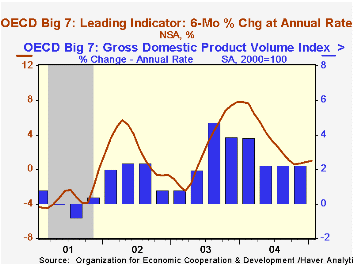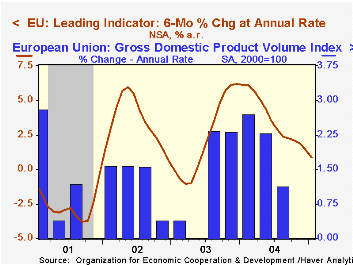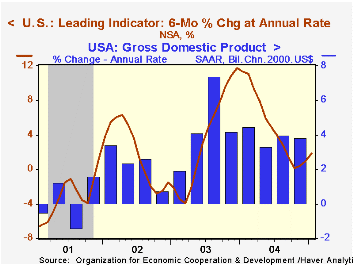 Global| Mar 14 2005
Global| Mar 14 2005OECD Leading Economic Index Up Again
by:Tom Moeller
|in:Economy in Brief
Summary
The Leading Index of the Big 7 OECD economies rose 0.2% in January for the third consecutive month. The steady rise lifted six month growth in the index to its best since September. During the last ten years there has been a 69% [...]

The Leading Index of the Big 7 OECD economies rose 0.2% in January for the third consecutive month. The steady rise lifted six month growth in the index to its best since September.
During the last ten years there has been a 69% correlation between the q/q change in the GDP Volume Index for the Big Seven countries in the OECD and the change in the leading index.
The leading index for the US economy provided the lift to the OECD composite as it increased 0.6% in January for the third consecutive monthly rise following three down months. Six month growth improved to 1.9% from a low of 0.1% in October due to higher share prices, consumer sentiment and construction which offset a tighter yield curve.The leaders for Japan stuttered with no change in January but six month at 1.3% remained up from zero in September due to gains in share prices and construction that offset a tighter yield curve.
Growth in the leaders for the UK economy went even more negative as higher short term interest rates and poorer export prospects offset increases in consumer confidence and share prices.The Canadian leaders rose for the first month following seven consecutive months of decline and growth remained a negative 2.2%.
A second 0.1% monthly decline in the leaders for the European Union (15 countries) pulled the six month growth rate to 0.9%, it's weakest since mid-2003. Growth in the leaders for Germany dropped to 1.5%, down from 8.6% in December 2003, due to a negative yield curve, a poor business climate and a negative orders inflow. The French leaders' also steadily deteriorated and growth went slightly negative versus the high of 8.4% early in 2004 due to a tighter yield curve and few job vacancies The leaders' in Italy fell 0.2% for the second month and six month growth fell to -0.5% due to higher short term interest rates, negative consumer confidence and deteriorating terms of trade.
The latest OECD Leading Indicator report can be found here.
This 2003 report from the US Federal Reserve Board gives An Empirical Analysis of Inflation in OECD Countries. 

| OECD | Jan | Dec | Y/Y | 2004 | 2003 | 2002 |
|---|---|---|---|---|---|---|
| Composite Leading Index | 102.54 | 102.32 | 1.0% | 101.97 | 97.50 | 96.34 |
| 6 Month Growth Rate | 1.0% | 0.8% | 3.6% | 2.5% | 2.3% |
Tom Moeller
AuthorMore in Author Profile »Prior to joining Haver Analytics in 2000, Mr. Moeller worked as the Economist at Chancellor Capital Management from 1985 to 1999. There, he developed comprehensive economic forecasts and interpreted economic data for equity and fixed income portfolio managers. Also at Chancellor, Mr. Moeller worked as an equity analyst and was responsible for researching and rating companies in the economically sensitive automobile and housing industries for investment in Chancellor’s equity portfolio. Prior to joining Chancellor, Mr. Moeller was an Economist at Citibank from 1979 to 1984. He also analyzed pricing behavior in the metals industry for the Council on Wage and Price Stability in Washington, D.C. In 1999, Mr. Moeller received the award for most accurate forecast from the Forecasters' Club of New York. From 1990 to 1992 he was President of the New York Association for Business Economists. Mr. Moeller earned an M.B.A. in Finance from Fordham University, where he graduated in 1987. He holds a Bachelor of Arts in Economics from George Washington University.






